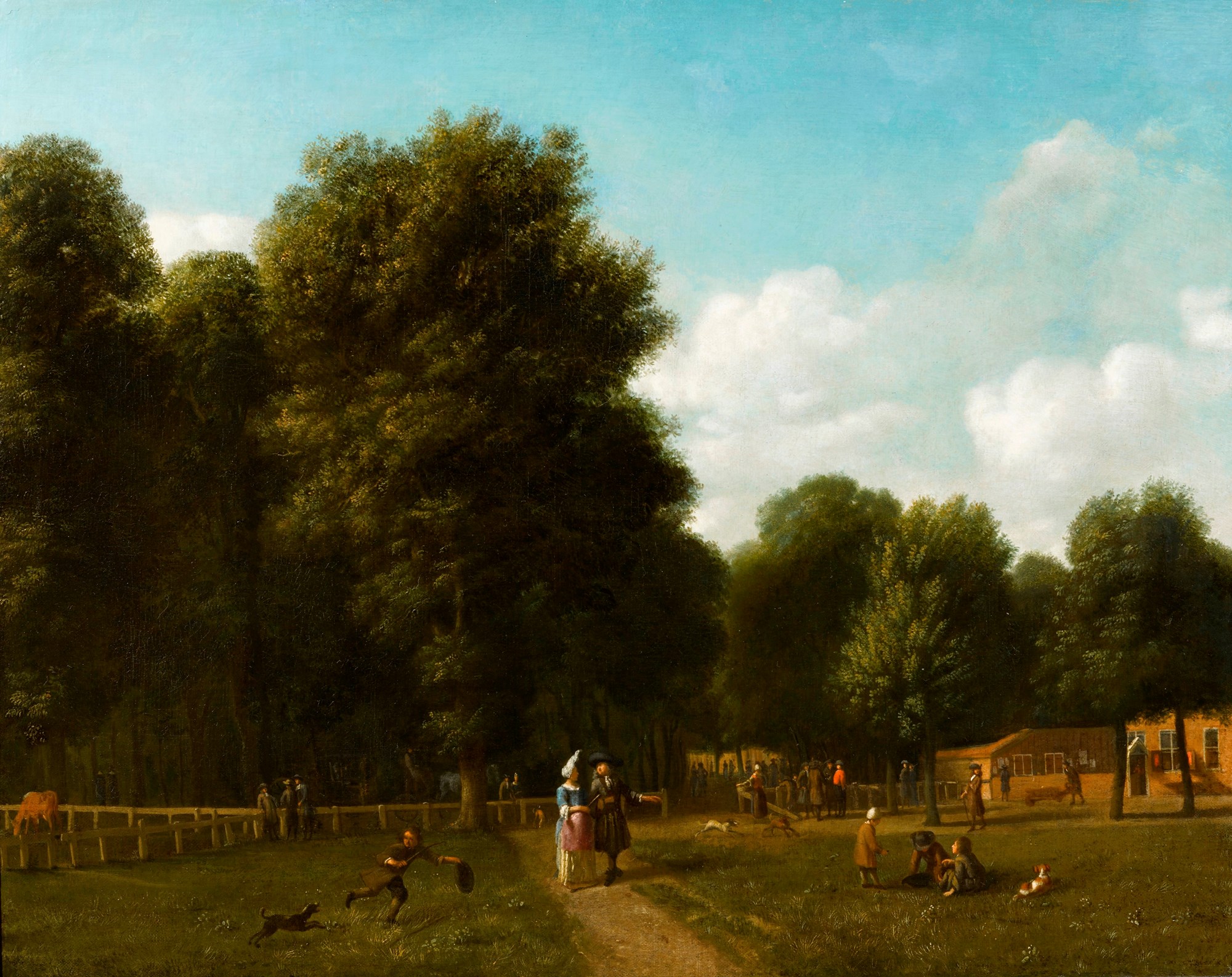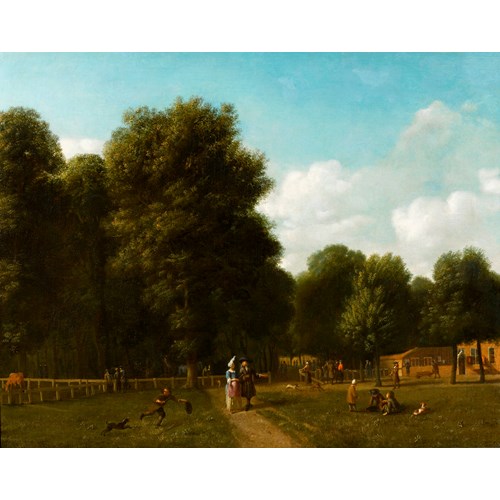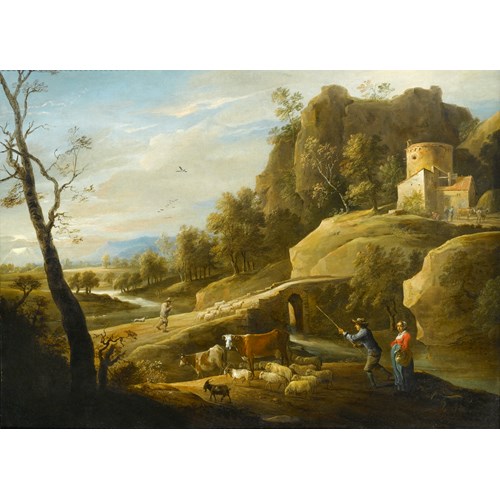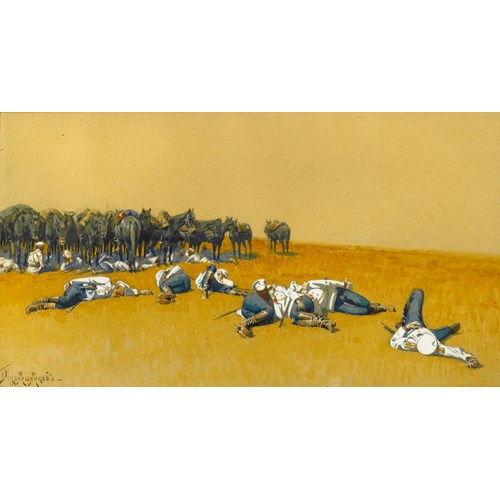Marketplace
A View of the the Haarlemmerhout, Haarlem
Gerrit Adriaensz. Berckheyde
A View of the the Haarlemmerhout, Haarlem
Date 1672
Epoque 1600-1750, 17th century
Origine The Netherlands
Medium Oil on canvas
Dimension 59.7 x 74.8 cm (23¹/₂ x 29¹/₂ inches)
The present painting is a slightly unusual example of the work of the preeminent chronicler of seventeenth-century Haarlem life, Gerrit Adriaensz. Berckheyde. It depicts the Haarlemmerhout, the oldest public park in the Netherlands, and there appears to be a wide range of Haarlem society visible in the work. Well-to-do figures stroll in the foreground or ride in the carriage amongst the trees on the left-hand side, and they stand in contrast to the image of a cow grazing in its paddock. Elsewhere we see the exuberant figures of children and dogs, whilst on the right-hand side we see two figures moving slowly through the park; one because he is pushing a heavy wheelbarrow, whilst the other, holding a walking stick, has the leisure to move serenely and elegantly.
As mentioned, the Haarlemmerhout is the oldest public park in the Netherlands, and it lies on the southern side of Haarlem. It was never locked and so was a source of refuge for the city’s citizens to come and relax, and, as shown in Berckheyde’s work, was common ground for farm animals. The park has changed appearance considerably over the years: it was burned by the Spanish army during the siege of Haarlem (1572-1573), and so much of the wood had to be replanted. Then, in the eighteenth-century, Jan van Vorel redesigned much of it in keeping with the fashionable English style, which created more open spaces and vista, with a greater emphasis on recreation.
Although Berckheyde is primarily known as a painter of urban views, he also painted a number of landscapes ‘which recall the lyrical renditions of foliage and planted areas in his cityscapes’.¹
Cynthia Lawrence also records one further view of the Haarlemerhout, which is dated 1672 (Private Collection). In that view, Berckheyde focuses more on the park’s agricultural use, due to the prominent placing of cattle. The present work, however, has more in common with Berckheyde’s famous city views. If we compare it to The Grote Markt and St. Bavo’s Haarlem, we see a similar preoccupation with depicting the range of Haarlem’s society. On the left-hand side we see a similar elegant couple strolling through the scene and again one of the figures holds out their arm, a dramatic gesture which is a classic Berckheyde motif. In both works a dog and a child at play threaten to interrupt the couple’s progress. Both paintings are flooded with the warm light that is such an unmistakeable feature of Berckheyde’s work, so that the natural effects of light and shade are manipulated to create a dramatic space. Although the paintings have very different settings, in each case Berckheyde’s ‘seemingly remote and dispassionate attitude to his subjects’ is evident, so that the figures appear to move serenely and calmly through the scenes.²
We are grateful to Marijke de Kinkelder, of the RKD, The Hague, for confirming the attribution on the basis of photographs.
¹ Lawrence., C. Gerrit Berckheyde, (Ghent, 1991), p.89.
² Ibid. p. 13.
As mentioned, the Haarlemmerhout is the oldest public park in the Netherlands, and it lies on the southern side of Haarlem. It was never locked and so was a source of refuge for the city’s citizens to come and relax, and, as shown in Berckheyde’s work, was common ground for farm animals. The park has changed appearance considerably over the years: it was burned by the Spanish army during the siege of Haarlem (1572-1573), and so much of the wood had to be replanted. Then, in the eighteenth-century, Jan van Vorel redesigned much of it in keeping with the fashionable English style, which created more open spaces and vista, with a greater emphasis on recreation.
Although Berckheyde is primarily known as a painter of urban views, he also painted a number of landscapes ‘which recall the lyrical renditions of foliage and planted areas in his cityscapes’.¹
Cynthia Lawrence also records one further view of the Haarlemerhout, which is dated 1672 (Private Collection). In that view, Berckheyde focuses more on the park’s agricultural use, due to the prominent placing of cattle. The present work, however, has more in common with Berckheyde’s famous city views. If we compare it to The Grote Markt and St. Bavo’s Haarlem, we see a similar preoccupation with depicting the range of Haarlem’s society. On the left-hand side we see a similar elegant couple strolling through the scene and again one of the figures holds out their arm, a dramatic gesture which is a classic Berckheyde motif. In both works a dog and a child at play threaten to interrupt the couple’s progress. Both paintings are flooded with the warm light that is such an unmistakeable feature of Berckheyde’s work, so that the natural effects of light and shade are manipulated to create a dramatic space. Although the paintings have very different settings, in each case Berckheyde’s ‘seemingly remote and dispassionate attitude to his subjects’ is evident, so that the figures appear to move serenely and calmly through the scenes.²
We are grateful to Marijke de Kinkelder, of the RKD, The Hague, for confirming the attribution on the basis of photographs.
¹ Lawrence., C. Gerrit Berckheyde, (Ghent, 1991), p.89.
² Ibid. p. 13.
Date: 1672
Epoque: 1600-1750, 17th century
Origine: The Netherlands
Medium: Oil on canvas
Dimension: 59.7 x 74.8 cm (23¹/₂ x 29¹/₂ inches)
Provenance: anonymous sale, Christie’s, London, 24 July 1987, lot 27, as ‘Attributed to Job Adriansz. Berckheyde’;
anonymous sale, Sotheby’s, New York, 12 January 1989, lot 38.
Plus d'œuvres d'art de la Galerie









